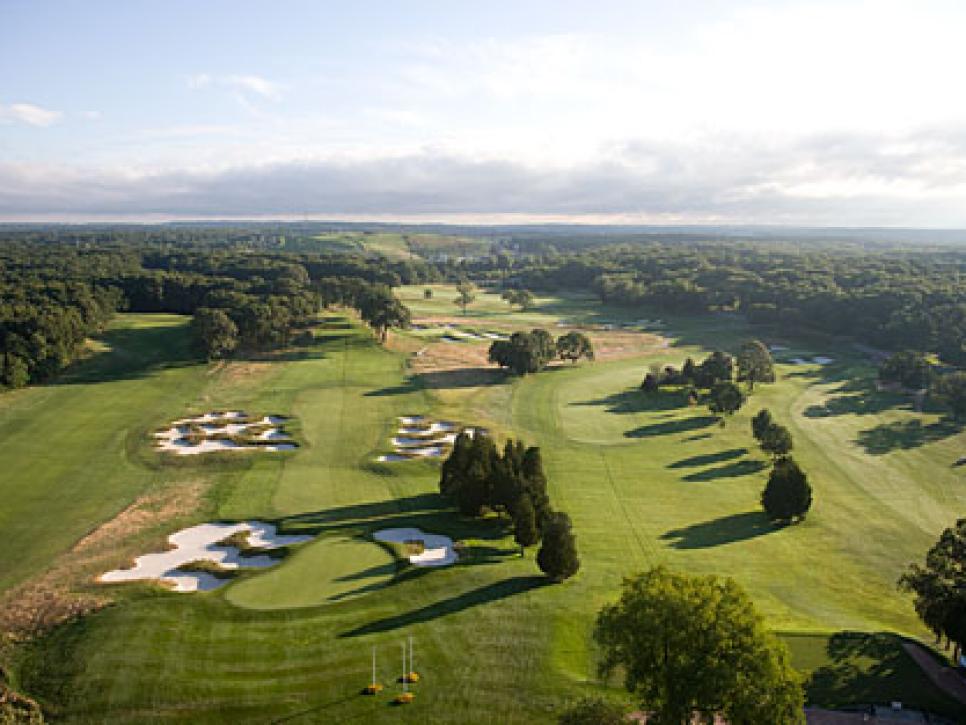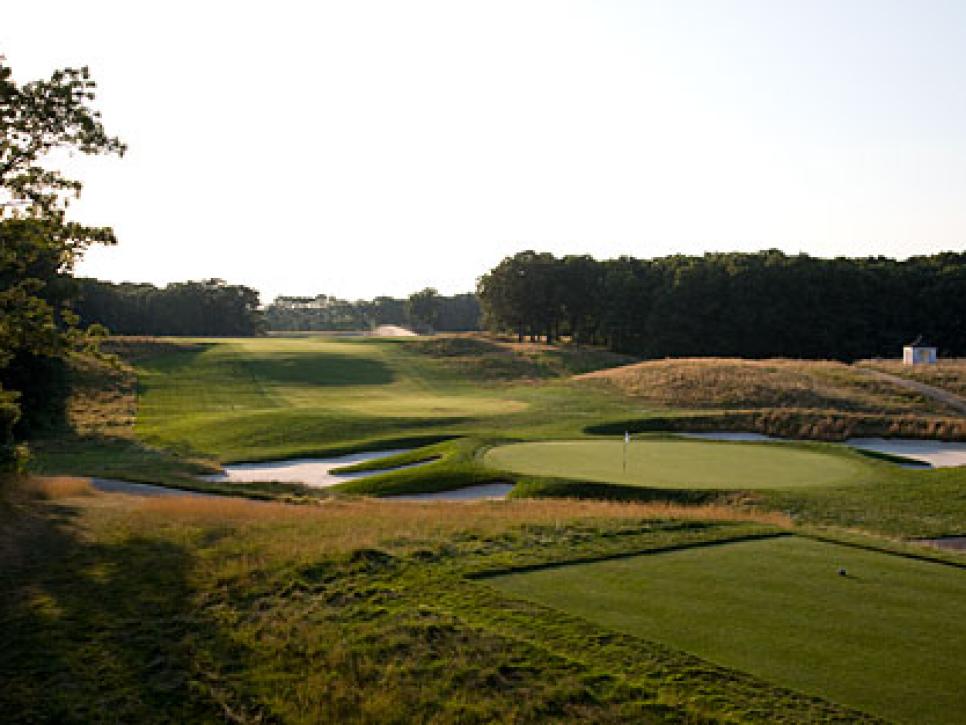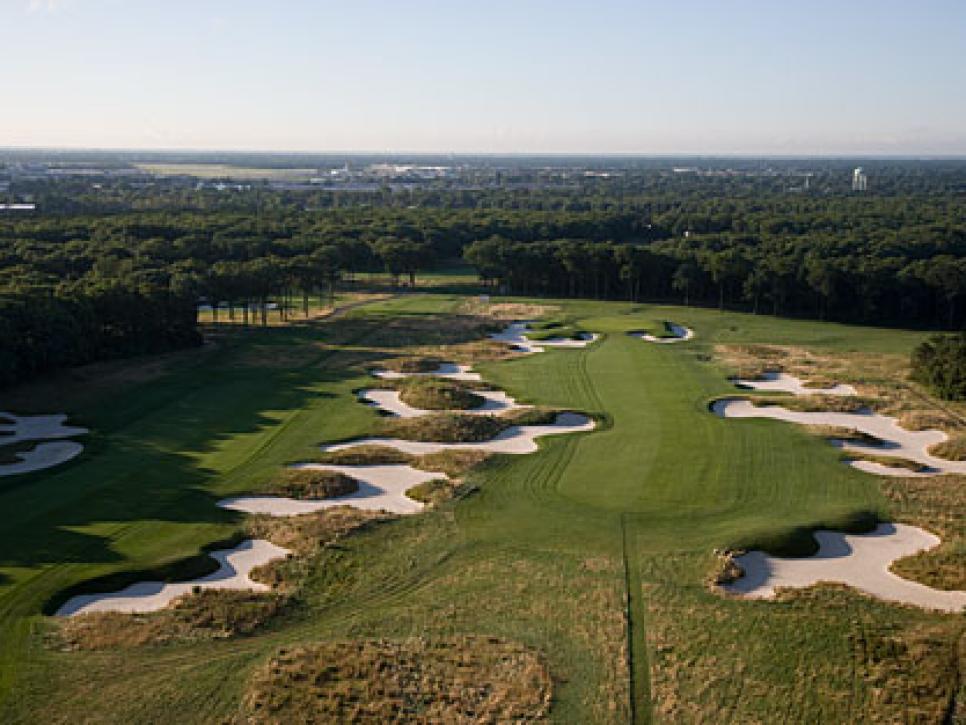News
Right Place, Right Time

The Black opens with a downhill dogleg-right par 4 (tee is in right foreground) and closes with a well-bunkered uphill par 4 (green is in left foreground).
When America needs its spirit renewed, it turns to Bethpage.
In the Great Depression of the 1930s, it was Bethpage that put thousands back to work reconstructing a portion of one golf course and adding three more 18s, not to create a private playground for the corporate elite, but to form "the people's country club," a fanfare for the common man that has now sounded for more than 70 years.
While the smoke and sorrow of Sept. 11, 2001 still lingered above New York City and the entire nation, it was the 2002 U.S. Open at Bethpage Black that got people cheering once again—and jeering, too, for that's part of the price championship golfers must pay when they invade the people's turf.
Now, in the midst of the worst economic plight since the breadlines and Hoovervilles of the 1930s, the Open returns to Bethpage Black, to provide four days of escapist entertainment of the highest order, and to remind us that good things can emerge from bad times, that governments sometimes do have brilliant ideas and that the game of golf will remain strong as long as it never forgets its grass roots.
Bethpage was conceived by Robert Moses, the most powerful unelected public official of the 20th century, but owes its implementation to Joseph H. Burbeck. As manager of the Bethpage Corporation in 1934, Burbeck supervised the design and construction of the complex, at the start drawing upon the talents of design consultant A.W. Tillinghast, the legendary architect who candidly credited Burbeck with the ambition of making the Black Course as great and severe a test as Pine Valley.
Sadly, Tillinghast never viewed the finished product. Burbeck, however, became the superintendent of Bethpage State Park in 1937 and presided over the place until his retirement in 1964.
The spirit of Bethpage waned after that, along with its conditioning, for 30 years, until USGA executive director David Fay decided the U.S. Open should sometimes go to courses that are accessible and affordable to all. Thus began the rediscovery of Bethpage Black and its subsequent reinvigoration.
Architect Rees Jones and his senior design associate Greg Muirhead handled the resurrection of the Black Course prior to the '02 Open, transforming a dandelion patch into a sparkling jewel on a bargain-basement budget.
Jones and Muirhead returned last year to lengthen and strengthen the course even more, again using limited financial resources. The Black now measures 7,426 yards, par 70, up from 7,214 yards in the 2002 Open. Its new tees will cause headaches as well as backaches.
A new one on the fifth, stretching the par 4 to 478 yards, now brings a diagonal carry bunker on the right very much into play. The farther left players aim to avoid it, the more likely their approach shot to the elevated fifth green will be hampered or blocked by overhanging trees on the left.
The dogleg-right seventh, normally a par 5, was played as a 489-yard par 4 during the '02 Open. A new tee now makes it a 525-yard par 4, but Jones widened the fairway along the left after seeing several players drive it through the dogleg in 2002.
The par-4 ninth goes from 418 yards to 460 yards, and Jones has added a new carry bunker on the inside corner of this dogleg left. It takes a 296-yard drive to clear the bunker, but there is fairway mowed on the bunker's far slope to reward those who gamble and clear it.

The par-4 10th is also longer, now 505 yards, but its fairway has been extended 40 yards closer to the tee to avoid the controversy of 2002, when several players (from the 492-yard tee) couldn't reach the fairway and ended up in deep fescue. The same thing happened in '02 on the 504-yard par-4 12th, so its fairway has been widened on the right to provide a bailout alternative. As at the ninth, Jones re-turfed the backside of a carry bunker on 12, and it will be mown as fairway.
No hole comes closer to Burbeck's desire to instill the image of Pine Valley into the Black than the 435-yard par-4 11th. From the tee, the narrow fairway is engulfed by acres of sand left and right, with more bunkers pinching the green. At the urging of Mike Davis, the USGA's senior director of rules and competitions, Jones tightened the 11th fairway even more this year by expanding bunker lobes on both sides closer to the centerline.
The par-5 13th will be 51 yards longer than it was in 2002, now measuring 605 yards. While some will still be able to reach the green in two, most of the field will have to contend with a nasty, steep-faced fairway bunker short right of the green on their second shots.
The last of the newly expanded holes is the downhill par-4 16th, now 490 yards long, with a fairway so skinny it looks like an apostrophe from the tee.
Despite all the length, the biggest changes to the course occurred on two of the shortest holes. At the downhill par-3 eighth, which previously played over a pond that really wasn't a factor, front and rear pin positions, re-established before the 2002 Open, now have added hazards. For this year, the slope just short of the green was re-grassed to be tightly mown, so anything landing short of the green could likely roll back into the pond. A grass hollow left of the green has likewise been re-turfed, posing a tougher recovery pitch shot from a tight lie.
The hole locations give Davis extreme flexibility. With the pin in front, perched just above the pond, he could move the tees well forward, to 156 yards if he wishes. With a pin on the back shelf, guarded by deep bunkers left and behind, he can push the tee markers to the max, 210 yards to the center of the green, another 23 yards to the back edge. Or he can come up with variations in between.
The par-3 14th doesn't offer quite so much set-up creativity, but recent changes there make it the most improved hole on the course. In 2002 it played 161 yards to a rather ordinary, canted, oval green protected by one large deep bunker at the front right, shaded in the back by a dense forest of trees. Last year, Davis asked Muirhead if it would be possible to add a front-left hole location. They created a narrow thumb—just 12 yards wide—on the front left, protected by the big bunker on the right and a new serpentine bunker on the left. They also flattened a dome along the back of the green to make it possible to cut a hole there as well, thus bringing the steep ravine behind—now devoid of trees—into play for overly aggressive shots.

The 14th green now looks a bit like the fourth at Augusta National (which also has a very narrow front-left thumb flanked by bunkers) but plays much shorter, listed at just 158 yards for this year's Open. Davis might move the markers up to the 140-yard range when the hole is cut in the narrow thumb.
The ultimate in flexibility is Davis' notion of a drivable par 4 during an Open. He successfully achieved it at the 14th hole at Torrey Pines South last year, and he is giving thought to moving markers 45 yards forward on the Black's 408-yard dogleg-left sixth on Saturday or Sunday to pose the possibility of cutting the corner and reaching the green, 50 feet below the fairway, from the tee.
Jones doesn't think Davis will do it. The essence of a good drivable par 4, he says, is genuine risk and reward. "Torrey Pines had that last year, with a canyon wrapped around the sides and back of the 14th green. Bethpage doesn't have that. There are just bunkers around the green. It wouldn't be nearly as risky or as exciting."
Plus, it would be a blind tee shot. Of course, even at 408 yards, it is a blind drive over a hill, unless one chooses to lay up to the plateau fairway at the 240-yard range. Without visible bait, it is less likely players would be tempted to go for it from the front tee.
Not that it matters. Bethpage Black will provide genuine thrills for players and spectators regardless of the set up. That's its mission. Always has been. Always will be.